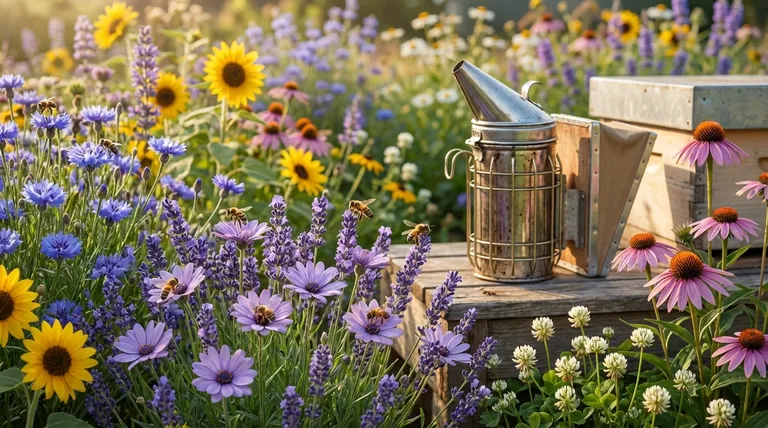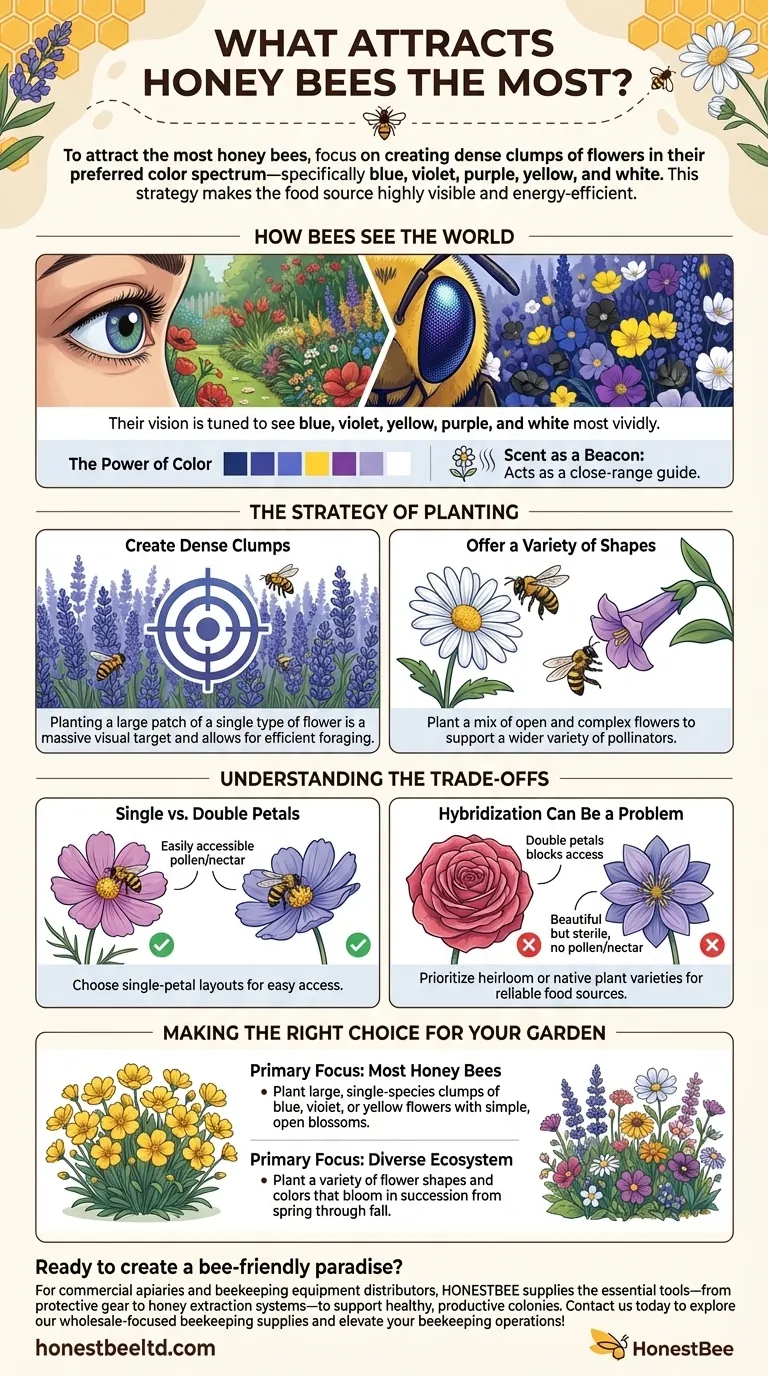To attract the most honey bees, focus on creating dense clumps of flowers in their preferred color spectrum—specifically blue, violet, purple, yellow, and white. This strategy makes the food source highly visible and energy-efficient for them to find and forage.
A truly bee-friendly garden isn't just a collection of pretty flowers; it's a strategically designed environment that caters directly to how bees see, navigate, and gather resources. The key is to think in terms of color, density, and accessibility.

How Bees See the World
A bee's perception is fundamentally different from ours. Understanding this difference is the first step in creating a space they will actively seek out.
The Power of Color
Bees are particularly drawn to a specific range of colors. Their vision is tuned to see blue, violet, yellow, purple, and white most vividly.
Red, for instance, appears as black to a bee and is generally ignored. Focusing your planting on their preferred color palette is the single most effective way to make your garden stand out.
Scent as a Beacon
While color is the long-range attractant, scent acts as a close-range guide. Many bee-friendly flowers emit scents that signal the presence of nectar and pollen, helping to guide the bees in for a landing.
The Strategy of Planting
How you arrange your flowers is just as important as which flowers you choose. Efficiency is critical for a foraging honey bee.
Create Dense Clumps
Planting a large patch or "clump" of a single type of flower is far more effective than scattering individual plants around.
A dense grouping creates a massive visual target that is easy for bees to spot from the air. It also allows them to forage efficiently, moving from one flower to the next without wasting energy in flight.
Offer a Variety of Shapes
While a single honey bee colony is the target, different bee species have tongues of varying lengths, suited for different flower shapes.
By planting a mix of open, daisy-like blossoms and more complex, tubular flowers, you support a wider variety of pollinators, creating a healthier overall ecosystem.
Understanding the Trade-offs
Not all flowers are created equal in the eyes of a bee. Many popular garden varieties, while beautiful to us, offer little to no value for pollinators.
Single vs. Double Petals
Choose flowers with single-petal layouts, where the pollen and nectar are easily accessible.
Many highly cultivated "double-petal" flowers, like certain roses or peonies, have been bred for looks at the expense of function. Their dense petals often block access to the pollen and nectar, making them useless for bees.
Hybridization Can Be a Problem
Some modern hybrids are bred for traits like disease resistance or unique colors but are sterile, producing no pollen or nectar.
Prioritizing heirloom or native plant varieties often provides a more reliable and nutritious food source for honey bees and other local pollinators.
Making the Right Choice for Your Garden
Your approach can be tailored to your specific goal, whether it's maximum bee traffic or broad pollinator support.
- If your primary focus is attracting the most honey bees: Plant large, single-species clumps of blue, violet, or yellow flowers with simple, open blossoms.
- If your primary focus is supporting a diverse ecosystem: Plant a variety of flower shapes and colors that bloom in succession from spring through fall.
By designing your garden from a bee's perspective, you can create a vibrant and essential resource for these critical pollinators.
Summary Table:
| Key Attraction Factor | Why It Works |
|---|---|
| Color Spectrum | Bees see blue, violet, yellow, purple, and white most vividly. |
| Dense Planting | Large clumps of flowers create a high-visibility, energy-efficient target. |
| Flower Shape | Single-petal, open blossoms provide easy access to pollen and nectar. |
| Scent | Acts as a close-range guide to signal nectar and pollen availability. |
Ready to create a bee-friendly paradise? For commercial apiaries and beekeeping equipment distributors, HONESTBEE supplies the essential tools—from protective gear to honey extraction systems—to support healthy, productive colonies. Contact us today to explore our wholesale-focused beekeeping supplies and elevate your beekeeping operations!
Visual Guide

Related Products
- Economy Galvanized Beekeeping Honey Bee Smoker for Wholesale
- Professional Bee Smoker with Elongated Spout and Durable Bellows for Beekeeping
- HONESTBEE Professional Entrance Bee Feeder Hive Nutrition Solution
- Wooden Bee Brush with Triple Row Artificial Fiber for Beekeeping
- Wooden Queen Bee Excluder for Beekeeping
People Also Ask
- What type of smoke is needed to calm honey bees? Use Cool, White Smoke for a Safe Hive Inspection
- What are the common design features of a bee smoker? Choose the Right Smoker for Your Apiary
- What is the purpose of a bee smoker in beekeeping? Ensure Calm, Safe Hive Inspections
- How did early beekeepers use bee smokers? Master Ancient Bee Calming Techniques
- What is the purpose of a bee smoker? Calm Bees for Safer, More Efficient Hive Inspections



















